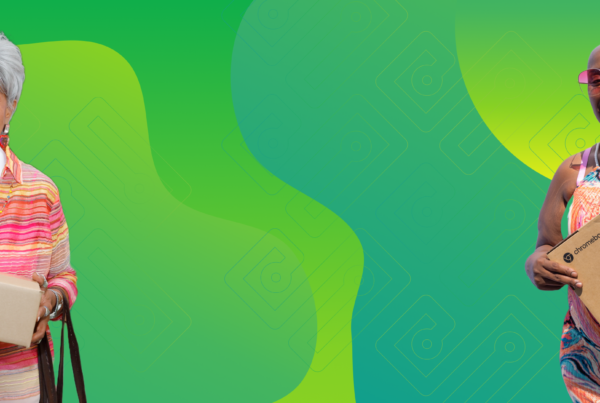When we at Human-I-T say we want to create a world where everyone has equal access to digital technology, it must be understood that we’re describing digital equity.
However, this begs the question: to what end is achieving digital equity good for?
Why is achieving digital equity such an imperative for not just ourselves, but for an increasingly large audience of policy makers, non-profit professionals, and corporate partners?
Simple: because achieving digital equity is a prerequisite to achieving any iteration of social equity.
Skeptical of that claim? Keep reading as we explore how internet access impacts people’s abilities to secure housing, find jobs and increase wages, and maintain their health.
The definition of digital equity
Before we go any further, we must reach a common understanding of what digital equity is.
To do that, we look to organizations that shape the conversations around digital equity like the National Digital Inclusion Alliance (NDIA) or the Benton Institute for Broadband and Society. According to NDIA, digital equity can be defined as:
A condition in which all individuals and communities have the information technology capacity needed for full participation in our society, democracy, and economy. Digital equity is necessary for civic and cultural participation, employment, lifelong learning, and access to essential services.
This is roughly in line with how Human-I-T views digital equity, as well. When asked how he would define digital equity, Human-I-T CEO and co-founder, Gabe Middleton, had this to say:
“When we talk about digital equity, we envision a future in which all people and communities are empowered with the tools, skills, and knowledge they need to use digital platforms in their everyday lives.”
While we wholeheartedly agree with these definitions of digital equity, we’d like to expand on it and acknowledge the digital divide. With that goal in mind, a more common definition of digital equity emerges that reads something like this:
Digital equity is a societal condition in which all people and communities are empowered to leverage digital tools, connectivity, and support without added systemic barriers to access, affordability, or usage in order to fully participate in our society, democracy, and economy.
So, now that we have a shared idea of what we’re driving towards, let’s evaluate how having equal access to digital technology impacts people’s daily lives across three areas: housing, employment, and health.
A lack of access to internet-connected technology elongates the suffering of houseless individuals
When non-profits and social enterprises talk about empowering the most vulnerable populations, one group springs to mind: the unhoused.
According to the most recent Annual Homeless Assessment Report released by the US Department of Housing and Urban Development (HUD), 326,000 individuals were experiencing houselessness on any given day in 2021. To most people reading this, that number is shockingly high but unsurprising.
After all, houselessness has been on the rise in America for nearly the past five years. Given this fact, advocates for houseless individuals have been lobbying policy makers on the local, state, and federal level to increase access to critical resources that make it easier for their clients to secure permanent housing.
Chief among those resources identified as critical in the fight against houselessness? The internet. According to a survey taken by New York City’s City Bar Justice Center in 2019, residents of homeless family shelters said that, if they had reliable access to the internet within their shelter, they would use it for: finding permanent housing (70%); finding a job (60%); finding medical care (63%); and accessing benefits like unemployment, SSI, SNAP, and Medicaid (45%).
Interviews with former residents of these homeless shelters corroborate this survey’s findings. Select comments from formerly houseless individuals include the acknowledgement that they “might have been living in an apartment sooner” and that “[they] would [have been able to] get access to a better job” if their shelter had internet access sooner. One resident even went so far as to say: “The only reason [they] got out of the shelter was because a hotspot let [them] find out about Housing Connect, [but] a lot of shelter residents don’t even know that exists.
Unfortunately, while the benefits of internet access remain clear, the vast majority of current residents in homeless shelters are precluded from this life changing resource. According to that same survey, 67% of respondents reported being unable to regularly access the internet through their shelter. This number represents over 10,000 families in the New York City metro area alone.
The picture becomes even more dire when we recognize that there is a racial component that has yet to be addressed in this analysis. When speaking about New York City, for example, people of color are disproportionately represented among those experiencing houselessness. Currently, 86% of single adults experiencing houselessness in New York City and 93% of heads of households in family shelters are Black or Hispanic. This is compared to the 53% of NYC’s population as a whole who identify as Black or Hispanic.
Suddenly, the gravity of the situation is clear. A lack of access to internet-connected technology is all but ensuring that houseless individuals – specifically houseless black and brown individuals – continue toiling while trying to get back on their feet.
Given this realization, let’s continue our analysis and see how access to digital technology affects people’s ability to get and retain employment.
Digital equity is a must-have to ensure everyone has an equal chance at participating in the economy
One of the most often reported-on phenomena of this decade is the rise of telework in the wake of the pandemic. This newfound fascination with a relatively old practice is not unwarranted; the percentage of Americans primarily working from home climbed from 6% in February 2020 to over 33% by May 2020.
But while teleworking levels soared, so too did unemployment. Between January and April 2020, unemployment levels in the United States increased by 10 percentage points. Approximately 90% of the workers laid off during this initial wave of unemployment worked in jobs which could not be completed remotely. Of course, extraordinary impacts to unemployment are to be expected in extraordinary conditions like a pandemic.
However, this phenomenon was not measured across the board. Let’s look at two counties in Mississippi for examples. Chickasaw County saw its unemployment rate rise from 5.1% to over 30% between January and April 2020. Bolivar County, on the other hand, only observed an increase in its unemployment rate from 7.5% to 11.1% during the same period.
What explains this stark difference? Well, if you ask researchers from the Journal of Regional Analysis and Policy, the answer might be broadband internet access at home. According to their 2022 study on the impacts of telework on employment levels during the pandemic, these researchers found that, when controlling for age, race, sex, and local industry composition, counties with broadband adoption rates of over 60% were likely to observe lower nominal rises in unemployment levels between January and April 2020than counties with broadband adoption rates lower than 60%.
These findings are consistent and provide an antonymous response to the findings of Mizzou researchers Catherine Isley and Sarah Low in their 2022 paper Broadband adoption and availability: Impacts on rural employment during COVID-19, which states:
“During the height of pandemic-related disruptions, broadband availability and wired broadband adoption both had statistically significant, causal relationships with the employment rate in low-population rural counties. Specifically, a one percentage point increase in the rate of broadband availability would have led to a 0.37 percentage point increase in the employment rate (p < 0.001)”
It’s also worth noting that there is an outsized, negative impact on the ability of seniors, people of color, indigenous people, and rural Americans without access to broadband to secure employment. According to the Pew Research Center, 43% of Americans with incomes less than $30,000 per year report not having access to broadband-connected technology at home. This is compared to just 7% of Americans with incomes over $100,000 per year who report not having similar access to broadband.
However, it would be foolhardy to simply assume that providing access to broadband-connected technology would ameliorate unemployment rates by itself. Instead, we recognize that bridging the device and broadband gap are only two parts of the three-component puzzle that is the employment digital divide. The final, and perhaps trickiest to solve, part is the digital skills gap, and it must be addressed before automation really begins to crunch the labor market.
According to a 2021 report by OECD, 32% of jobs are at significant risk of automation before the end of the decade due to increased digitization of the economy. Given this, it stands to reason that the designation of a worker as “high-skill” will be predicated on their ability to work with increasingly complex digital systems as part of their job. I.e.: show not just digital literacy, but digital fluency.
This comes at a time of increased outsourcing of low-skill jobs, as well as the increasing share of workers who rely on gig work to make ends meet. This creates a doubly troublesome scenario for the ability of America’s low- and middle-skilled workforce to compete in the economy of tomorrow.
As the share of Americans relying on gig work and non-standard employment rises, workers within those industries will be forced to upskill to increase their wages. The same is true, however, for middle-skill workers who wish to elevate their career prospects and wages by securing high-skill jobs.
At the same time, there will still be a variety of jobs which require socio-emotional skills which can be completed by low-skill workers, such as housekeepers, hairdressers, etc. Should either the low-skill or middle-skill employee fail to upskill and show competency with increasingly complex digital technologies, they will both have to compete for the same low-skill job, which may push wages for those jobs even further down.
Such conditions would not only be disastrous for workers themselves, but for the global economy as a whole. In its 2021 assessment of the global skills gap, Accenture estimated that the global economy stands to lose out on nearly $12 trillion in growth by 2028 if it cannot solve the digital skills gap. Unfortunately, the global workforce – even its younger participants – are not suited to meet this moment. According to a 2021 study conducted by the Learning and Work Institute, 52% of employers observed that young people were leaving higher education without sufficiently advanced digital skills.
However, yet again, there exists stark differences in which populations are most significantly affected by the digital skills gap. While 82% of 16 – 24 year olds (young workers) have at least basic digital skills, only 35% of 55 – 74 year olds (older workers) have similar skills. Additionally, 49% of young white workers have advanced digital skills, compared to just 17% and 32% of young Black and Hispanic workers, respectively.
When one considers that affordability and accessibility are often the two biggest barriers to home adoption of broadband-connected technology, a grim image comes into view: low- and middle-skill workers – who are predominantly older people of color – are faced with a choice of spending time and money they often don’t have to get broadband-connected technology at home in order to scale and practice digital skills, or else be left in even more precarious economic straits by the end of the decade.
So, tell us again: how is allowing hundreds of millions of people to not have access to broadband-connected technology not a social equity issue? But, before we get ahead of ourselves, let’s evaluate one more area where access to technology can change – or, in this case save – lives: health.
For some, not having access to affordable internet at home is a matter of life and death. Literally.
In the onset of the pandemic, one digital technology that captured everyone’s attention was telehealth. At a time when visiting healthcare providers in-person was nigh on impossible, telehealth proposed a safer, more convenient alternative for billions of people around the globe.
And boy, did people use telehealth.
According to a 2021 retrospective by McKinsey, telehealth usage levels climbed by 3,800% between April 2020 and April 2021. Not only was telehealth used more often, but it was appreciated by consumers and providers alike: 75% of clinicians polled by the American Medical Association in 2021 reported that telehealth enabled them to provide quality care, and 55% of consumers polled by McKinsey in 2022 are much more satisfied with telehealth care than in-person care. Even more surprising is that preliminary data from the University of Pennsylvania shows that the normally-observed health outcome disparity along racial lines was slightly less pronounced during the pandemic due to the growth of telehealth.
That being said, this phenomenon begs the question: what was happening before the pandemic? Well, as we’re sure you can guess, the answer is that a lack of access to affordable internet at home and low-cost devices meant that low-income people were getting sick and were unable to access care.
Indeed, the data supports this hypothesis. According to the Federal Communications Commission, America’s least-connected counties have a 25% higher prevalence of obesity, a 41% higher prevalence of diabetes, and 150% higher prevalence of preventable hospitalizations compared to counties with high rates of broadband adoption. While some basic levels of digital skills are of course necessary to use telehealth, it shouldn’t be overlooked that increased access to broadband can still point to improved health outcomes.
The FCC found that counties in any quintile of broadband access have, on average, 9.6% lower diabetes prevalence than counties in the next lower quintile, even when controlling for that county’s average educational attainment, age, of per capita income. Even counties with the highest rates of diabetes in the country see this impact pan out, with increasing quintiles of broadband access correlating to a 3.8% reduction in diabetes prevalence for each higher quintile of broadband access observed.
Keep in mind: the counties we’re talking about are overwhelmingly rural, poor, and populated by Black, brown, and Indigenous people – the same people who are least likely to easily uptake digital skills. So, even in counties where the digital skills gap is most pronounced, simply increasing access to broadband-connected technologies has an observable, positive impact on the health outcomes of residents living there.
Promoting digital inclusion is the secret to attaining digital equity
At this point, it’s clear that achieving digital equity is non-negotiable if we want to cultivate broader social equity. However, in order to achieve this lofty goal, we need to meet people where they’re at and guide them towards becoming a digital citizen.
In practical terms, that means empowering digital inclusion organizations like Human-I-T and our colleagues to expand the reach of our programs and engage with more communities left on the wrong side of the digital divide.
Simply put, if digital equity is the destination, digital inclusion are the steps we take to get there.
At Human-I-T, we focus on four pillars of digital inclusion: affordable devices, low-cost internet access, digital skills training, and tech support for communities on the wrong side of the digital divide.
Collectively, these services move us toward a future in which all individuals and communities have the information and technology they need for full participation in our society, democracy, and economy.
By continuing to strive for this otherwise audacious goals, we will slowly, but surely, be on our way to creating a world where everyone has equal access to the opportunities they need to thrive.






